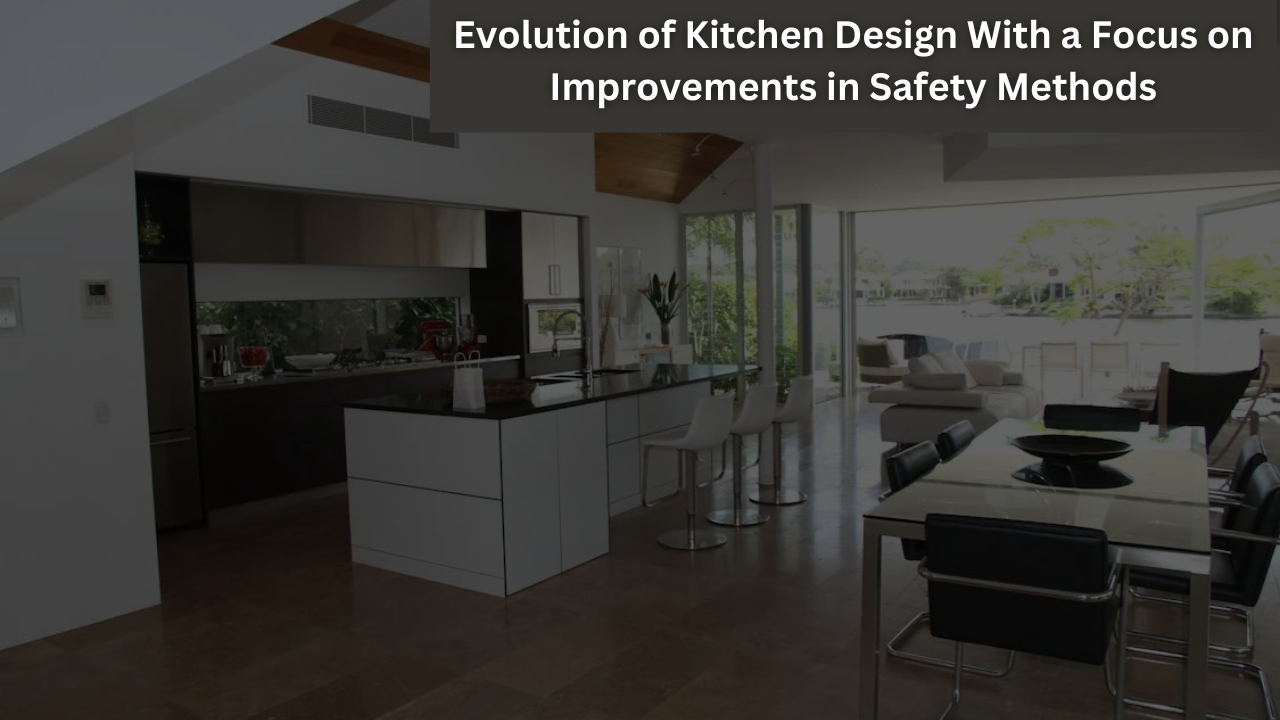The kitchen is considered as the heart of the house. This is the place where our daily routines start, right from preparing a coffee in the morning to cooking our night meal.
However, there have been a lot of kitchen transformations that have gone on over the centuries. Today’s kitchens are so much more than a place to cook; they are dynamic, multi-purpose spaces designed keeping aesthetics, technology, and comfort in mind. Most importantly, there have been a lot of improvements when it comes to safety measures.
In this article, we will look at how kitchen design evolved over the years, along with some of the challenges faced. Additionally, we will look at some of the key safety improvements in contemporary kitchens.
History of Kitchen Design and Safety Concerns
In earlier days, the kitchen used to be a part of the main living space. You would often find open flames being a key element of cooking. Therefore, you always had to be watchful to make sure that the fire didn’t spread to nearby flammable materials like wooden roofs or beams.
On the other hand, there was no proper ventilation which filled the entire living area with smoke when cooking. This further went on to cause respiratory issues and created an unsafe environment.
When we talk about the cooking utensils used, they were all just basic ones. Even the storage areas used to look disorganized with no proper planning.
Come the mid-19th century, things slowly started to change. You would eventually start to notice kitchens becoming dedicated spaces. Gas and electric appliances were introduced. However, the risk factor didn’t seem to end.
According to NFPA, cooking causes the majority of home fires, with almost half (49%) of them related to cooking equipment. This statistic shows the long-standing need for kitchen safety improvements. Additionally, it highlights the importance of design improvements in reducing these risks.
Even though these innovations replaced open flame risks, the gas and electrical appliances came with their own limitations. They carried risks of gas leaks, electrical shocks, burns, etc.
All these issues made way for modern kitchen design and safety standards to come into existence in the mid-20th century. As women started to step outside and work in the corporate sectors, they were forced to cook quickly, which increased the chance of an accident.
Additionally, home cooking habits changed as processed foods and ready-made recipes became more popular. This further impacted the safety concerns.
Modern Kitchen Design Trends
Innovative Materials
When we talk about modern kitchen design, the first thing that comes to the mind is usage of advanced materials to improve safety. Slip-resistant flooring is one of those key developments. It reduces the fall risks in a space that is usually susceptible to leaks and spills.
Fire-resistant countertops made from quartz materials or treated granite are another huge upgrade. These materials provide more protection against heat and accidental fires.
Additionally, non-toxic finishes with low VOC have been introduced which ensures that kitchen surfaces and coatings do not release harmful chemicals.
In 2022, the ECCC published a list of products that have limits on volatile organic compounds. This was to limit VOC emissions from certain products.
This particular report highlights the harm caused by VOC materials. Moreover, it encourages people to accept non-VOC materials as they emit less or no chemicals.
Smart Appliances
The incorporation of smart technologies into kitchen appliances has completely changed safety standards. For example, ovens with auto-shutoff feature automatically turn off the oven, if you leave it idle for too long, This will reduce the risk of fires.
According to Statista, global sales of the ‘Cookers & Ovens’ segment of household appliances will grow by 25.6 million pieces between 2024 and 2029. This data shows how well smart ovens are accepted worldwide and will continue to do so.
Similarly, smart smoke detectors have now started to come with real-time alerts and smartphone connectivity options in the past few years. This allows users to monitor their kitchen safety on the go.
Ergonomic Design
Ergonomic design principles have made kitchens safer and more user-friendly. Features like adjustable counters let you customize the workspace.
Worldmetrics.org states that proper kitchen ergonomics can lower musculoskeletal injuries among chefs and workers. For example, a tall person can raise the counter when preparing food and a shorter person can lower it. This will reduce strain and injuries.
Easy-to-reach storage solutions like pull-out drawers, lower cabinets, etc are another major upgrade that minimizes unnecessary bending and stretching.
Key Safety Improvements in Contemporary Kitchens
Pressure Cooker Safety
Pressure cookers are used in every household because of their ease of use and how effective they are. Having said that, they have their own set of safety concerns too. You might be wondering, can a pressure cooker explode?
The answer is, yes. According to TorHoerman Law, a pressure cooker’s steam release valve keeps the pressure inside the cooker and lets it out when it’s full. As a result, the pressure stays even throughout the cooking process.
However, clogged dirt and food particles could prevent the valve from working properly. In other cases, there could be some issues with the venting system.
Under such circumstances, there’s no way to control or release the pressure. Therefore, when you open the lid, water vapor or steam can get trapped inside the cooker and cause an explosion.
While these issues are quite common in old pressure cookers, modern pressure cookers come with a lot more features for safety. Today’s pressure cookers come with safety mechanisms like locking lids that restrict opening when the cookers are under pressure.
There are safety sensors as well that make sure that the cooker operates within safe parameters. Moreover, to improve safety and reduce accident risks, manufacturers now provide detailed instructions and safety guidelines. This will help you operate the pressure cooker safely and make the best use of it.
Fire Safety Features
Modern kitchens now come with built-in fire safety features that help in better managing and reducing fire risks. One such fire safety feature is automatic fire suppression systems which detect fires and automatically spray extinguishing agents to extinguish fire.
You will also find other features like induction cooktops where electromagnetic energy is used to heat the pot directly. This reduces burn and fire risk.
Child Safety Measures
There has been a conscious effort to improve child safety when it comes to modern kitchens. Hence, you will find features like childproof locks that are designed to keep away from accessing certain appliances inside the kitchens.
For example, you often see cleaning agents or knives stored in the kitchen. These are potentially harmful for kids. Therefore, to keep this way from children’s sight, childproof locks such as cabinet and drawer locks are used.
Additionally, you will also find covers for knives and other sharp tools to guard their edges and prevent accidental injuries.
In the past few decades, the kitchen has evolved from a simple cooking space into a modern cooking hub. This development has led to significant advances in safety, thanks to advancements in design, materials, and technology.
Although there’s been a lot of improvement, safety shouldn’t be taken for granted. When it comes to kitchen design and renovation, it’s important to stay up to date on safety guidelines. This helps keep kitchens functional, attractive, and safe, all at the same time.
Also Read:

